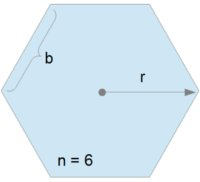The Weight of Snow on a Polygon calculator computes the approximate weight of snow on an POLYGON area (e.g. deck) based on the dimensions of the polygon (number of sides of the polygon and the radius) and the depth and type of snow.  Geometric Polygon
Geometric Polygon
INSTRUCTIONS: Choose units and enter the following:
- (n) The number of sides of the polygon
- (r) The radius of the polygon (from the center to any apex).
- (d) The depth of the snow
- (sT) Choose the type of snow from the list.
Weight of Snow (M): The Weight / Mass of the Snow is returned in kilograms. However this can be automatically converted to other weight and mass units (e.g. pounds or tons) via the pull-down menu.
| Type of snow or ice | (kg/m3) |
| Fresh New snow | 50-70 |
| Damp new snow | 100-200 |
| Settled snow | 200-300 |
| Depth hoar | 100-300 |
| Wind packed snow | 350-400 |
| Firn (granular) | 400-830 |
| Very wet | 700-800 |
| Glacier ice | 830-917 |
| Rain/Melt | 997 |
Hydrology (Water, Rain and Snow) Calculators:
- Snow Pack to Liquid Water Calculator
- Volume of water in snow or rain
- Weight/Mass of Snow on an Area.
- Weight of Snow on a Rectangular Area.
- Weight of Snow on a Roof.
- Weight of Snow on a Polygon Shaped Area.
- Volume of Water in a Rainfall
- Flow Rate of Broad Crested Weir
- Water Capillary Rise.
- Volume of Flood Water.
- Number of sandbags needed to build a wall or dike.
- Water Saturation Ratio
- Rain Fall Harvesting Calculator
- Peak Discharge from Drainage Basin Runoff
- Gauckler-Manning Equation
- Cipolletti Weir Flow Rate
- Acre-feet
The Math / Science
Snow Water Equivalent (SWE) is the product of snow depth and snow density. It can be presented in units of either kg/m2 or m:
SWE (`(kg)/(m^2)`) = snow depth (m) x snow density (`(kg)/(m^3)`)
SWE (m) = snow depth (m) x snow density (`(kg)/(m^3)`) / water density (`(kg)/(m^3)`)
You can calculate snow depth from SWE if you know the density of the snow. Od course, density of snow can range anywhere from 5% when ambient air temperature is 14 F, and can range up to 20% if the temperature is 32 F.
The snow density will increase after the snowfall due to gravitational settling, packing, wind effects, melting and refreezing.The equation will use a median value for the ranges in the density value column.